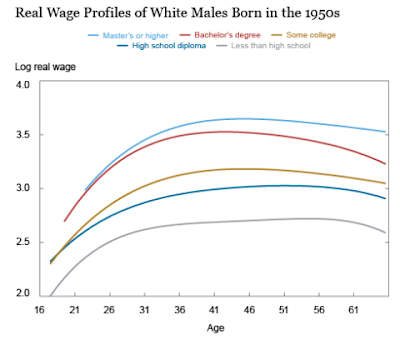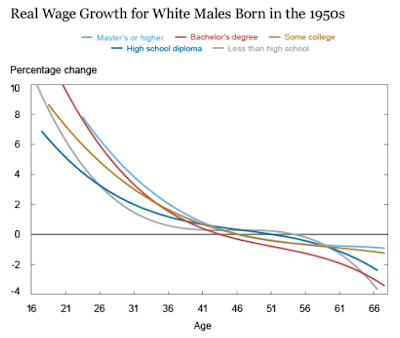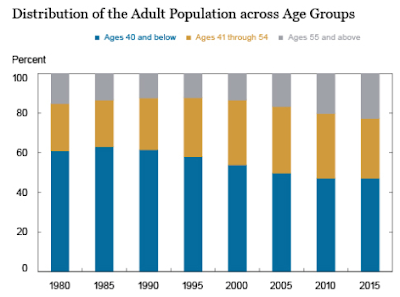This article was last updated on April 16, 2022
Canada: ![]() Oye! Times readers Get FREE $30 to spend on Amazon, Walmart…
Oye! Times readers Get FREE $30 to spend on Amazon, Walmart…
USA: ![]() Oye! Times readers Get FREE $30 to spend on Amazon, Walmart…
Oye! Times readers Get FREE $30 to spend on Amazon, Walmart…
A recent two-part article posted on the Liberty Street Economics website shows what lies ahead for the American economy when one considers the relationship between the aging of the labour force and the behaviour of real (after inflation) wage growth. For those of you who are not aware of the Liberty Street Economics website, it is a blog that is sponsored by the Federal Reserve Bank of New York, publishing analysis from economists that may or may not reflect the actual position of the FRBNY.
The authors, Robert Rich, Joseph Tracy and Ellen Fu, started by looking at real hourly wage growth rates for all employed individuals aged 16 and older over the period from January 1982 to May 2016 as well as the May data from 1969 to 1981 using the CPI to convert nominal hourly wages to real hourly wages in Q1 2014 dollars. The data is then divided into 140 different demographic cohorts based on decade of birth, gender, race and educational level (i.e. one cohort would be white male high school graduates born in the 1960s).
Here is an example of their findings which looks at the real wage profiles plotted on a logarithmic scale of white males born in the 1950s divided into groups based on educational attainment:
While this is only a single sample of the 140 cohorts, the five cohorts within the white male, born in the 1950s cohort, the authors found that the same pattern developed across all of their demographic cohorts. They observed that real wages tended to shift up as educational attainment rose and that real wages tended to rise early in a worker's career, flattening out in mid-career and declining as the worker approaches retirement.
While all of this is not terribly unexpected, the focus of the authors was to find out the implied growth rate of real wages, not simply the level of real wages, a task that is made easier because the authors used a logarithmic scale to plot the real wage profiles. The authors computed implied real wage growth rates as the slope of the estimated cohort-specific real wage profiles at a given age. As the slope of the line steepens, real wage growth increases. As the slope of the line flattens, real wage growth decreases. When the slope turns downward as age increases to the end of one's working career, the real level of wages is actually falling.
Here is a graphic showing the percentage of real wage growth for white males born in the 1950s by educational level and age:
All five educational levels show rapid real wage growth in the early part of their career with positive real wage growth ending in the mid-forties. At this point, real wage growth is either flat for less than high school graduates and declining for white males with some college. By the age of 55, all categories are experiencing negative wage growth; in other words, wage growth is not keeping up with inflation.
From my own personal experience in the workforce, early wage growth was at very high rates, partly because of the high inflation levels in the late 1970s and early 1980s, however, a great deal of the wage growth was related to on-the-job-learning and on-the-job-training. This generally makes a worker a more valuable commodity to their employer. After a few years, workers, myself included, tended to look for more suitable employment that better matches their acquired skills with a new employer. At this point, wage growth is also substantial. After that point, as workers age, there is a diminished incentive for employers to invest in on-the-job training since the worker's working like is shorter. This results in significant slowing of wage growth rates. As such, the authors found that real wage growth profiles can be divided into three segments:
1.) fast real wage growth up to age 40
2.) flat real wage growth between the ages of 41 and 54
3.) negative real wage growth over the age of 55
Now, how is this going to impact America's workforce. Here is a graphic showing how the age distribution of the adult population of the United States has changed between 1980 and 2015:
The authors' analysis shows that the fraction of the U.S. population that is in the fast real wage growth phase of their careers has dropped from nearly 60 percent in 1980 to just under 45 percent in 2015. As shown in this graphic, this aging of the American workforce has had a substantial impact on aggregate real wage growth rates since 1980:
Aggregate real wage growth for all workers in America has declined from 1.8 percent in the mid-1980s to 1.2 percent in 2015, a decline of 33 percent.
In conclusion, the authors note that U.S. real wage growth has slowed down over the past three and a half decades as the American workforce aged. With real wage growth becoming negative for workers over the age of 55, this trend will continue for the coming decades as the proportion of older workers rise. Since real wage growth generally reflects the rate of labour productivity growth, it certainly appears that the ongoing aging of the American workforce will negatively impact future labour productivity and wage growth, realities that will ripple through the economy, affecting future economic growth rates.
Click HERE to read more of Glen Asher's columns
You can publish this article on your website as long as you provide a link back to this page.





Be the first to comment